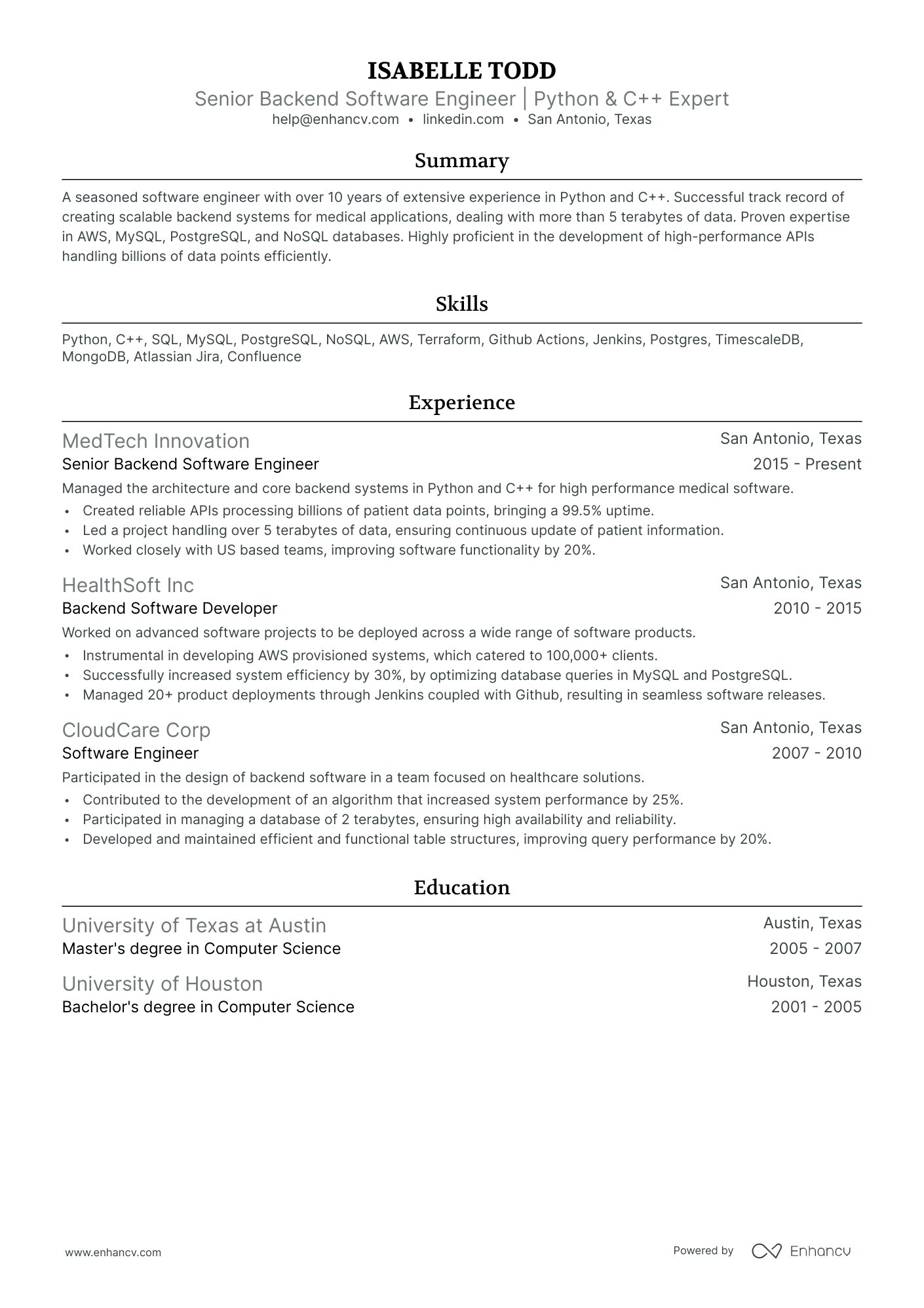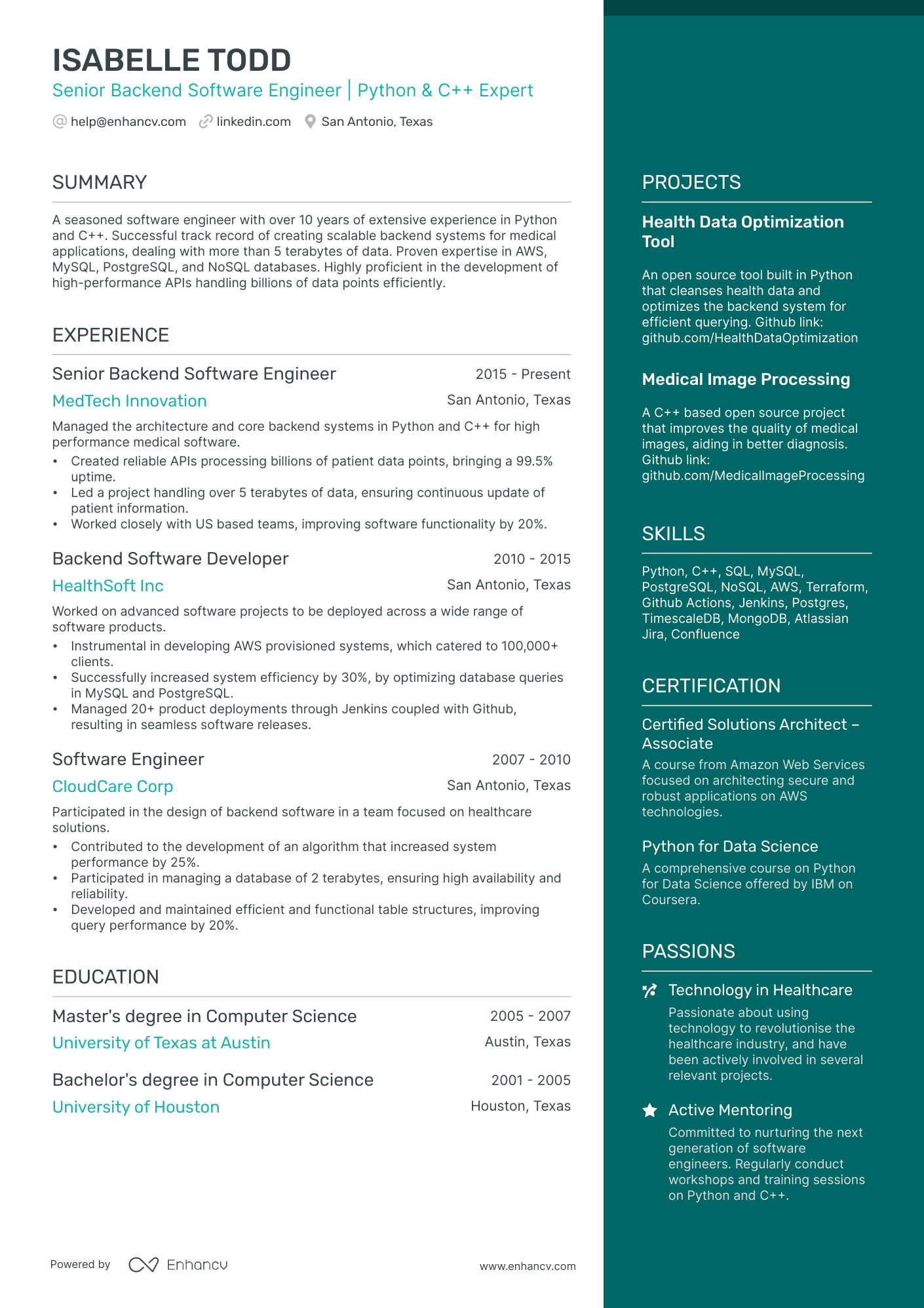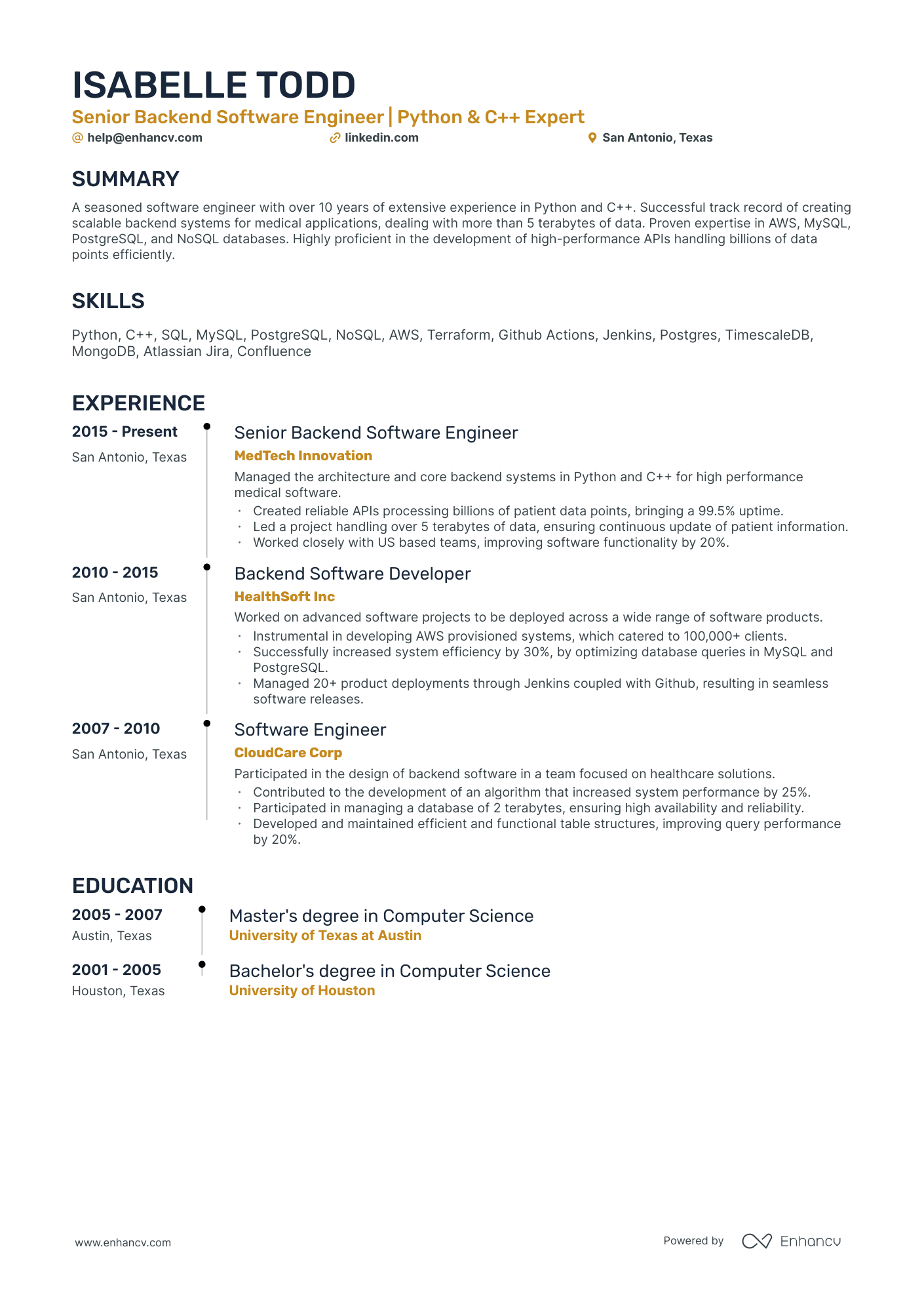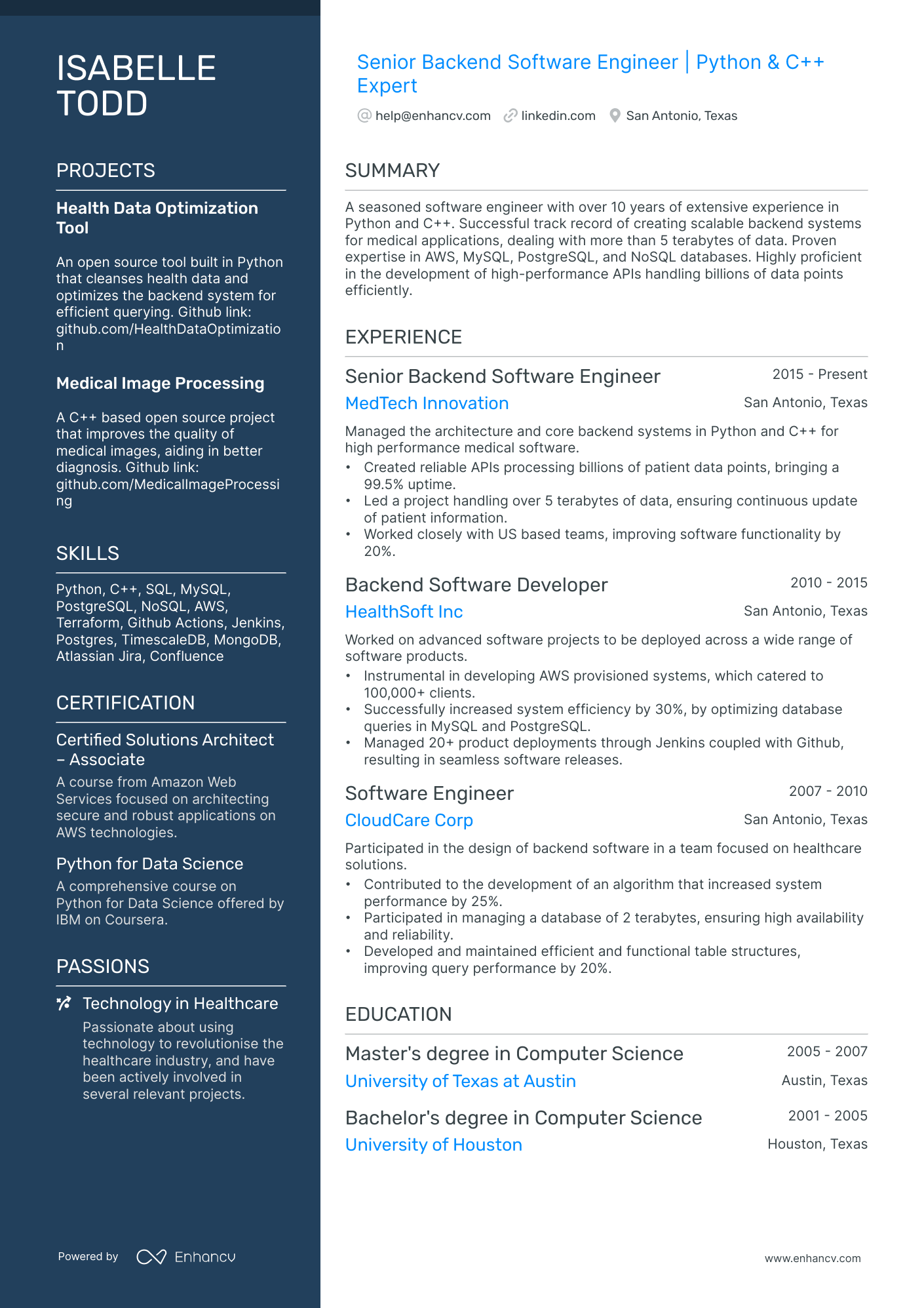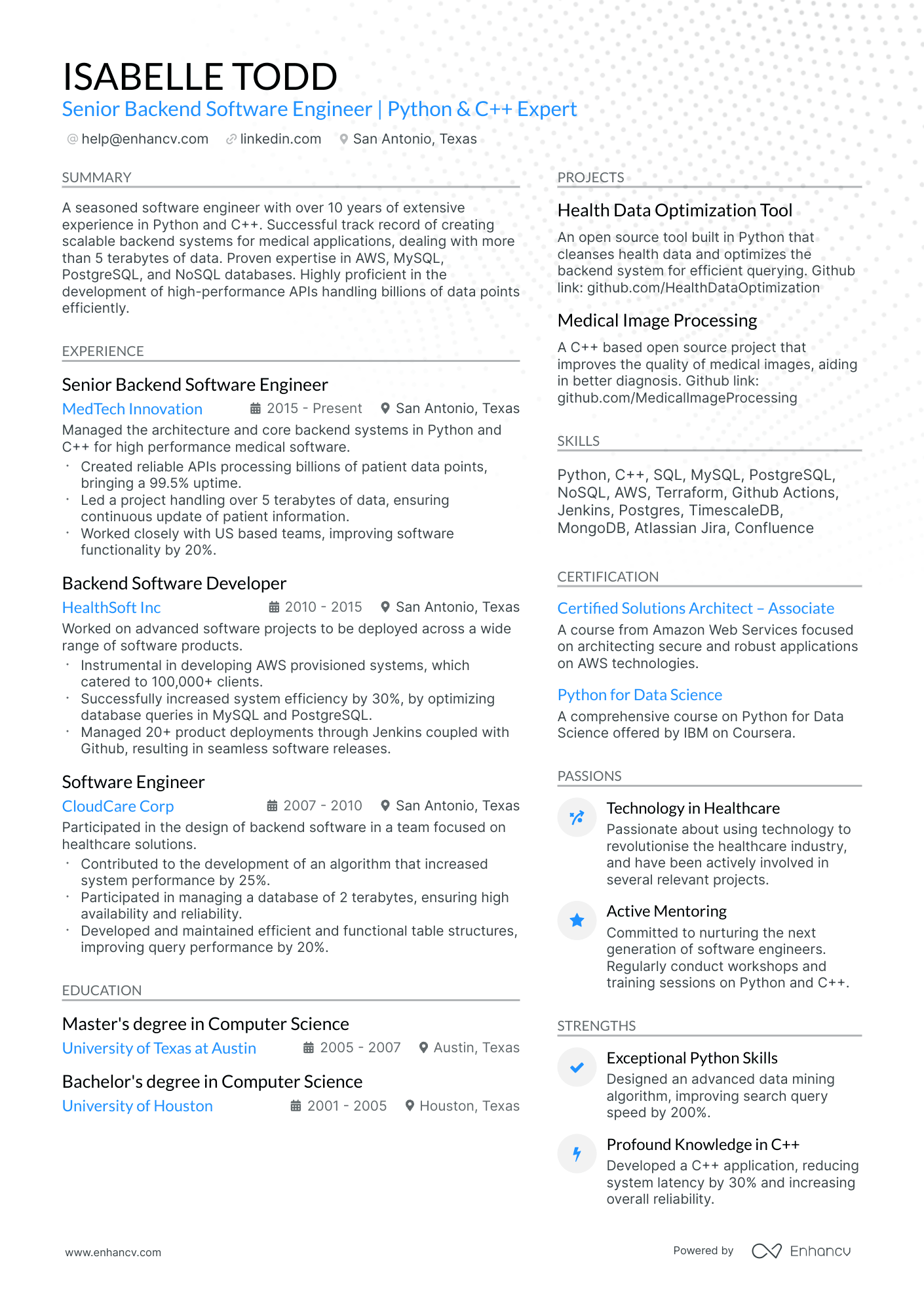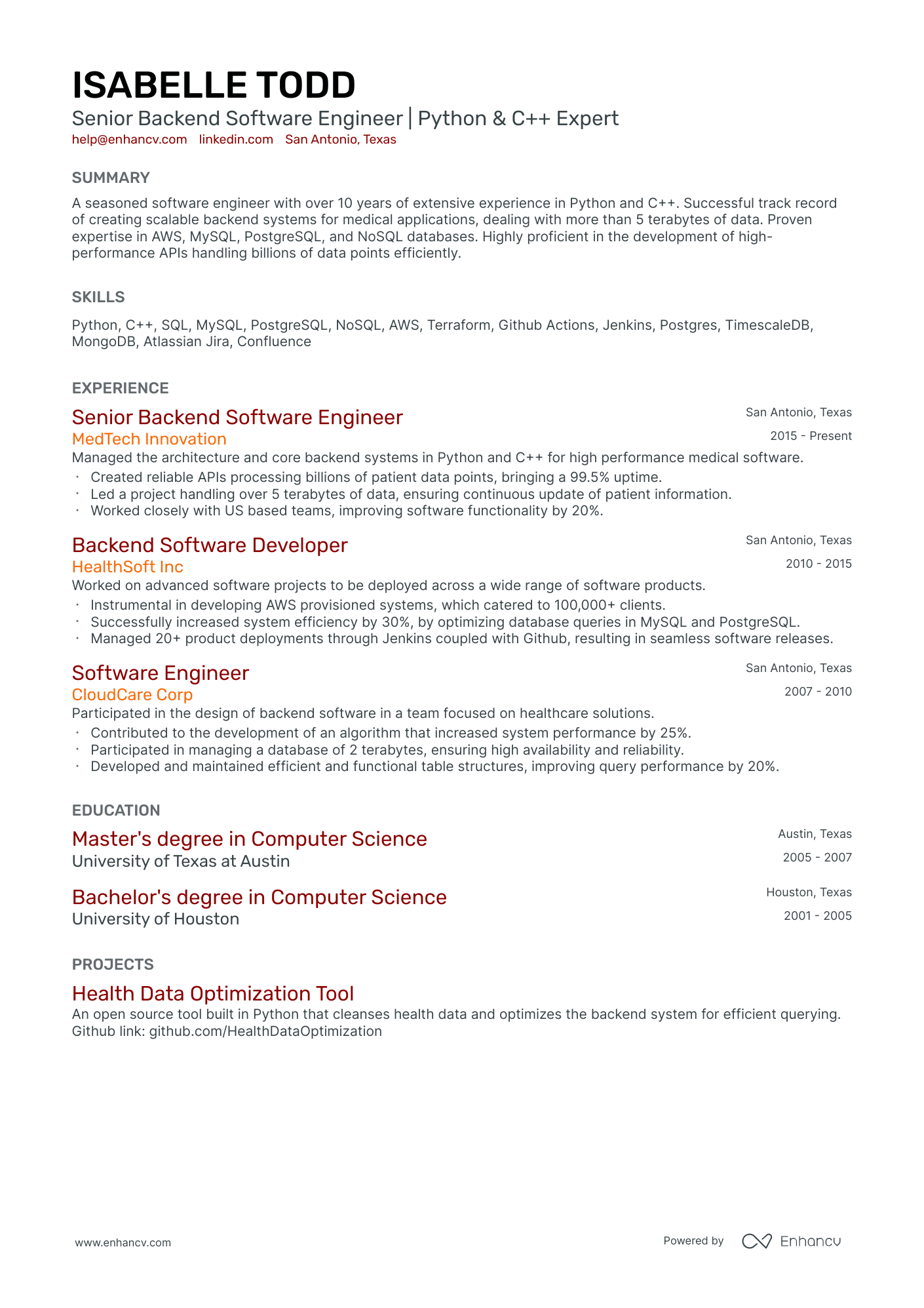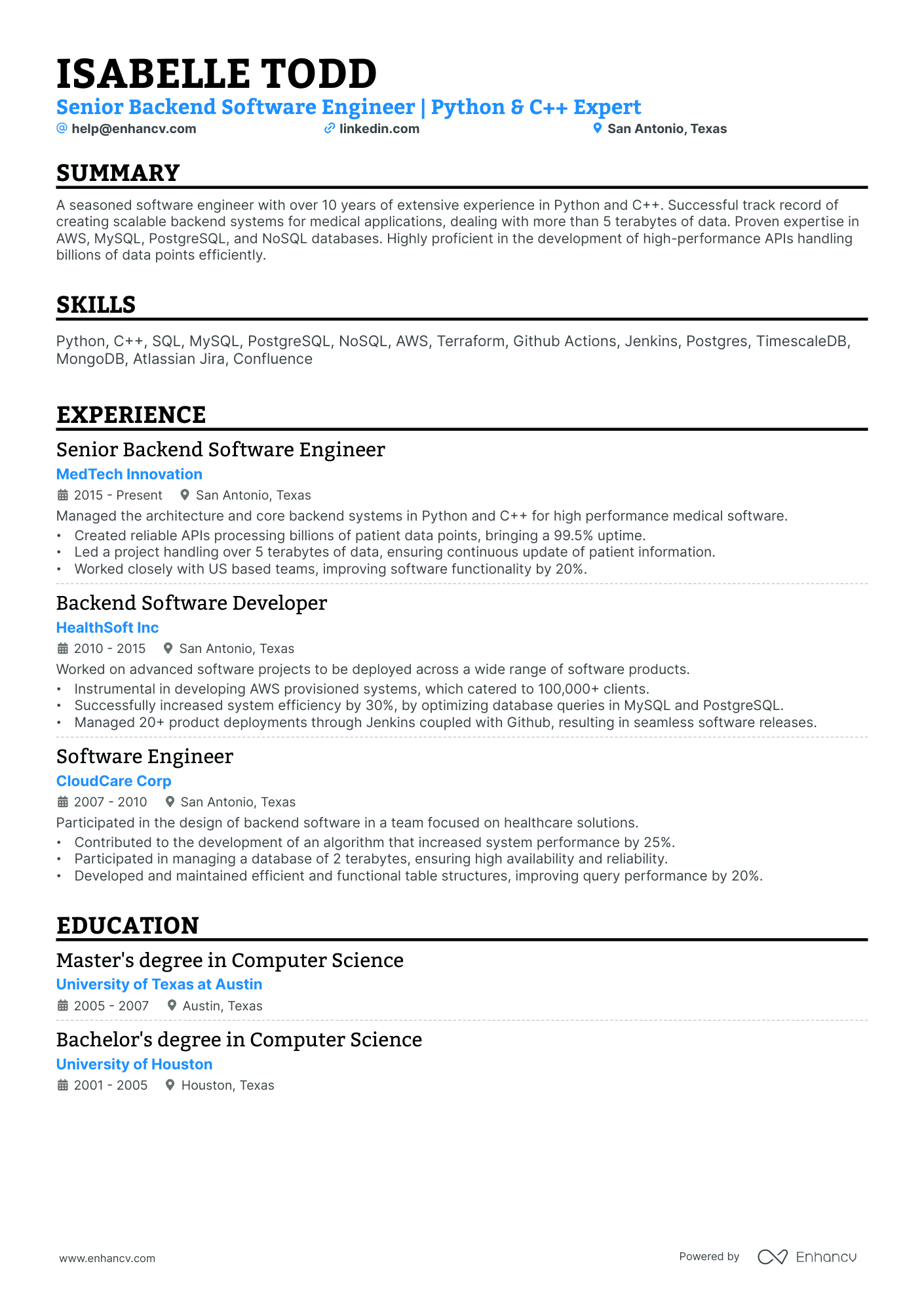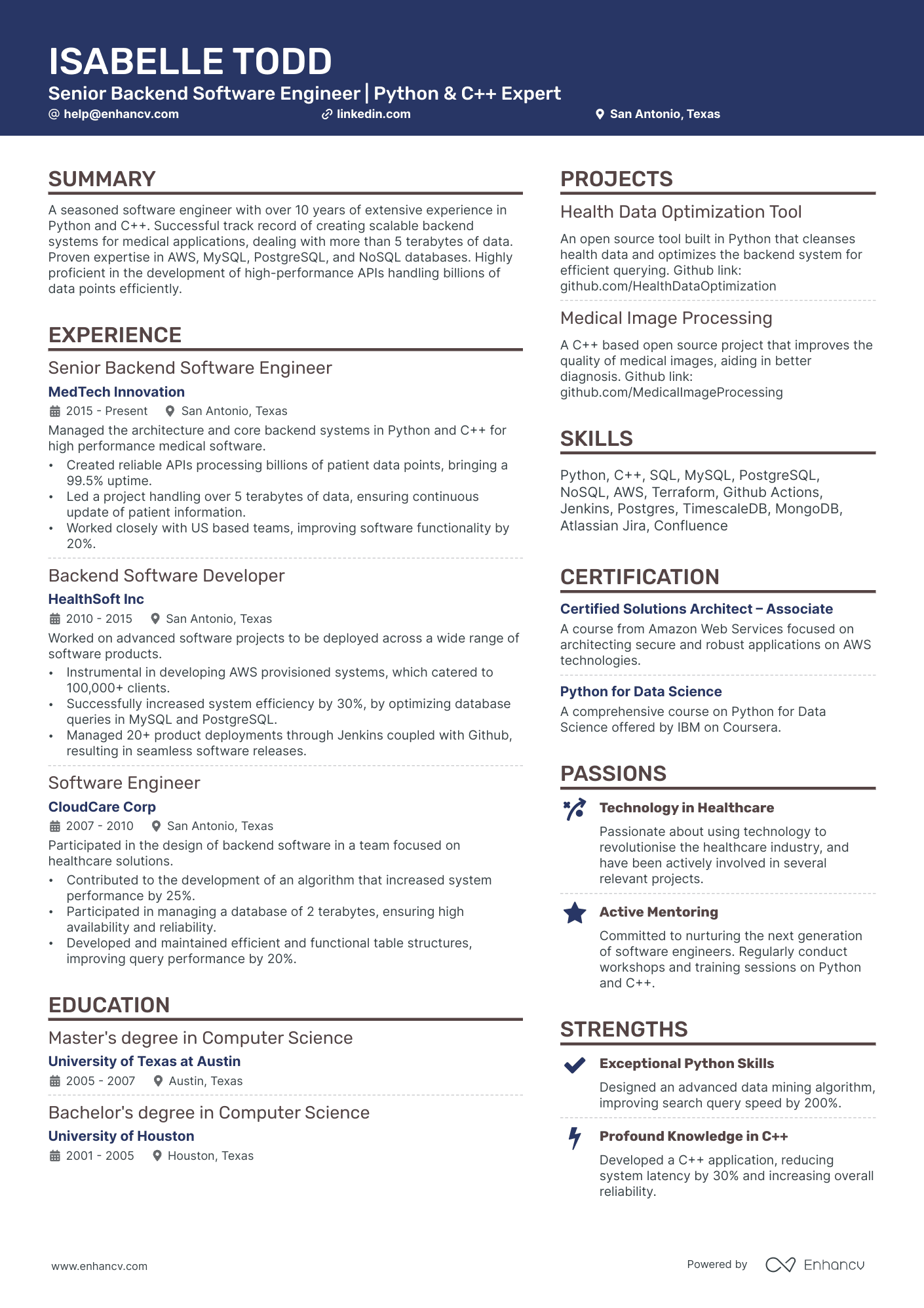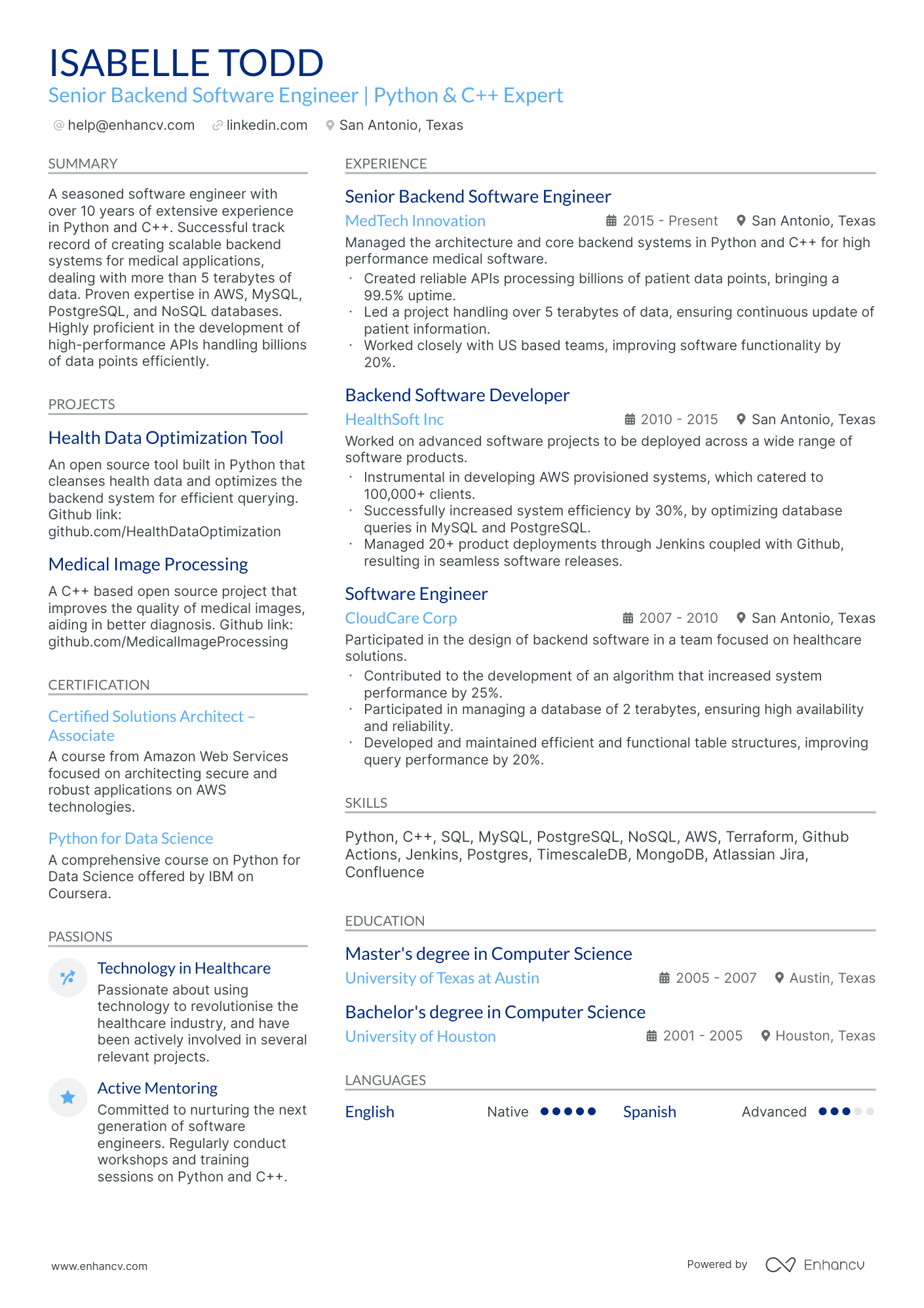One common challenge faced by cybersecurity engineers when creating their resumes is articulating technical skills and experiences in a way that non-technical recruiters can understand. Our comprehensive guide can assist by providing clear examples and tips on how to translate complex cybersecurity concepts and tasks into accessible language, enhancing the overall impact and comprehensibility of your resume.
Enhance your application for the cybersecurity engineer role with our concise guide on how to:
- Format your cybersecurity engineer resume, ensuring a balance between professionalism and creativity, in line with best practices.
- Align your resume with the cybersecurity engineer job requirements by incorporating relevant industry keywords.
- Utilize distinct resume sections to highlight your skills and achievements, making a case for why you're the top pick for the cybersecurity engineer role.
- Draw from leading cybersecurity engineer resume examples to effectively tailor your experience.
Recommended reads:
Structuring your cybersecurity engineer resume to engage recruiters
The presentation of your cybersecurity engineer resume is crucial.
Is it easy to read and well-organized? Does it have a logical flow?
Avoid overwhelming recruiters with a cluttered document. Instead, follow these best practices to ensure a consistent resume format:
- Include a header in the top third of your cybersecurity engineer resume for easy contact and quick access to your professional portfolio or LinkedIn profile.
- In the experience section, start with your most recent role and detail your career in a reverse-chronological order.
- Unless specified, submit your resume as a PDF to maintain its layout. Some companies might request other formats.
- If you're applying for a senior position and have over a decade of relevant experience, a two-page cybersecurity engineer resume is acceptable. Otherwise, aim for a single page.
Consider your target market – resumes in Canada, for example, follow different layout conventions.
Upload your resume
Drop your resume here or choose a file. PDF & DOCX only. Max 2MB file size.
Pro tip
At the end of the day, recruiters care most about how easily they can scan and read your resume layout. Unless you're aiming for a role in a creative field, it might be best to stick with a straightforward layout and format. Instead, put your energy into showcasing your experience.
Key sections to include in your freight broker resume are:
- The header - with your contact details (like email and phone number), a link to your portfolio, and a headline.
- The summary (or objective) - highlighting the high points of your career so far.
- The experience section - limit yourself to six bullets per role to focus on specific results.
- The skills list - offering a balanced mix of your personal and professional talents.
- Education and certification - displaying your most relevant degrees and certificates for the freight broker role.
What recruiters want to see on your resume:
- Relevant Certifications: Having certifications like CISSP, CISM, CEH, or CompTIA Security+ shows a strong commitment to the field and verifies a certain level of knowledge and skills.
- Experience with Specific Tools/Technologies: Experience with relevant tools such as firewalls, intrusion detection systems, or specific cybersecurity software (like Splunk, Wireshark) is essential. Also, familiarity with cloud-based environments (AWS, Google Cloud, Azure) can be highly desirable.
- Hands-on Incident Response Experience: Having handled real-life security incidents/breaches gives you valuable practical experience that is often prioritized by recruiters.
- Cybersecurity Project Experience: Be it designing a new secure network infrastructure, or leading a team for penetration testing, project-based experiences are highly valuable.
- Understanding of Legal and Regulatory Environments: Knowledge about laws, regulations, and standards affecting cybersecurity (like GDPR, ISO 27001, HIPAA) is critical in many roles.
Recommended reads:
Strategies for crafting your cybersecurity engineer resume experience section
When detailing your cybersecurity engineer resume experience, it's essential to pair responsibilities with tangible achievements.
Consider including:
- Key responsibilities, emphasizing their significance to your role, team, or organization.
- Experiences that have fostered your technical acumen or professional growth.
- Metrics that underscore your contributions and successes.
- Challenges you've addressed and the solutions you've implemented.
- Strategies you've devised and their measurable impact on growth.
Your experience section is pivotal in making a lasting impression on recruiters. To inspire you, we've curated real-world cybersecurity engineer examples:
- Implemented and managed security measures resulting in a 30% reduction in cybersecurity incidents at XYZ Company.
- Developed and executed vulnerability assessment and penetration testing plans, identifying critical vulnerabilities and providing recommendations for remediation.
- Collaborated with cross-functional teams to develop incident response procedures and conducted incident investigations, minimizing the impact of security breaches.
- Led the implementation of a Security Information and Event Management (SIEM) system, enhancing real-time threat detection capabilities.
- Managed the deployment and configuration of firewalls, intrusion detection systems, and other security infrastructure components at DEF Enterprises.
- Performed regular security audits and risk assessments, ensuring compliance with industry regulations and standards.
- Designed and executed a comprehensive employee cybersecurity awareness training program, reducing internal security incidents by 40%.
- Developed and implemented a secure network architecture for a major client, resulting in improved data protection and customer trust.
- Conducted thorough security assessments of web applications, identifying vulnerabilities and recommending appropriate countermeasures.
- Collaborated with the development team to integrate security controls into the software development lifecycle, ensuring secure coding practices.
- Managed the implementation of a Security Incident and Event Management (SIEM) solution, enabling efficient monitoring and response.
- Led the investigation and containment of a sophisticated cyber attack, minimizing data breach impact and ensuring business continuity.
- Developed and implemented security policies and procedures, aligning with industry best practices and regulatory requirements.
- Performed regular vulnerability assessments and penetration tests, identifying critical weaknesses and recommending remediation actions.
- Collaborated with cross-functional teams to design and deploy a secure cloud infrastructure for a global organization, enabling efficient and scalable operations.
- Provided incident response support during major security incidents, ensuring timely resolution and minimizing business impact.
- Managed security operations center (SOC) activities, including monitoring, analysis, and incident response for a large financial institution.
- Developed and implemented threat intelligence programs, enhancing proactive detection and response capabilities.
- Led the implementation of data loss prevention (DLP) technologies, reducing the risk of data exfiltration by 50%.
- Performed forensic investigations on compromised systems, identifying the root cause of security incidents and providing recommendations for mitigation.
- Conducted in-depth security assessments and risk evaluations for critical infrastructure systems, ensuring compliance with industry standards.
- Designed and implemented identity and access management (IAM) solutions, enabling secure and efficient user authentication and authorization.
- Developed and executed incident response plans, leading cross-functional teams in minimizing the impact of security breaches.
- Collaborated with external partners on joint cybersecurity initiatives, improving threat intelligence sharing and incident response coordination.
- Implemented secure network segmentation strategies, isolating critical assets and reducing lateral movement capabilities for potential attackers.
- Managed and optimized security technologies, including intrusion detection/prevention systems (IDS/IPS) and security information and event management (SIEM) tools.
- Led the development and implementation of a security awareness training program, resulting in a 25% decrease in successful social engineering attacks.
- Provided expert guidance on emerging cybersecurity threats and trends, assisting executive leadership in making informed risk management decisions.
- Conducted comprehensive security assessments and audits of third-party vendors, ensuring compliance with contractual security requirements.
- Designed and implemented a Security Operations Center (SOC) infrastructure, streamlining incident detection and response capabilities.
- Developed and delivered technical cybersecurity training sessions for internal teams, enhancing overall security awareness and knowledge.
- Led the development and testing of disaster recovery and business continuity plans, ensuring minimal disruption during cyber incidents.
- Led a team of cybersecurity engineers in conducting comprehensive risk assessments and vulnerability scans, resulting in improved security posture for clients.
- Developed and implemented secure software development methodologies, ensuring the delivery of robust and resilient applications.
- Collaborated with external auditors to perform security audits and achieve compliance with industry standards and regulatory requirements.
- Implemented advanced threat detection technologies, including behavioral analytics and machine learning, improving early detection of cyber threats.
- Managed security incident response activities, coordinating with internal teams and external stakeholders to contain and mitigate cyber threats.
- Designed and deployed a secure virtual private network (VPN) infrastructure, enabling secure remote access for a global workforce.
- Performed regular security assessments and penetration tests, identifying vulnerabilities and recommending appropriate remediation measures.
- Developed and delivered cybersecurity training programs for employees, promoting a culture of security awareness and best practices.
The following content includes information from "O*NET OnLine" by the U.S. Department of Labor, Employment and Training Administration (USDOL/ETA). Used under the CC BY 4.0 license. The data represents the top responsibilities present on the task lists for cybersecurity engineer professionals.
Top Responsibilities for Cybersecurity Engineer:
- Develop plans to safeguard computer files against accidental or unauthorized modification, destruction, or disclosure and to meet emergency data processing needs.
- Monitor current reports of computer viruses to determine when to update virus protection systems.
- Encrypt data transmissions and erect firewalls to conceal confidential information as it is being transmitted and to keep out tainted digital transfers.
- Perform risk assessments and execute tests of data processing system to ensure functioning of data processing activities and security measures.
- Modify computer security files to incorporate new software, correct errors, or change individual access status.
- Review violations of computer security procedures and discuss procedures with violators to ensure violations are not repeated.
- Document computer security and emergency measures policies, procedures, and tests.
- Confer with users to discuss issues such as computer data access needs, security violations, and programming changes.
- Monitor use of data files and regulate access to safeguard information in computer files.
- Coordinate implementation of computer system plan with establishment personnel and outside vendors.
Quantifying impact on your resume
<ul>
No experience, no problem: writing your cybersecurity engineer resume
You're set on the cybersecurity engineer role of your dreams. Yet, you have little to no work experience . Here's how you can curate your resume to substitute your lack of experience:
- Don't list every single role you've had so far, but focus on the ones that align with the job you're applying for
- Include any valid experience in the field - whether it's a university research project, or a summer internship
- Highlight the soft skills you're bringing along - those that will have an added value to your application.
- Focus on your education and certifications, especially if they make sense for the role.
Recommended reads:
Pro tip
The experience section is all about relevancy to the cybersecurity engineer role. Decide on items that will show your expertise and skills in the best possible light.
Decoding the essence of your cybersecurity engineer resume: hard and soft skills
Every job description communicates the desired hard and soft skills. These skills are the backbone of your application.
Hard skills are your tangible, technical proficiencies, often validated through certifications or hands-on experience. On the other hand, soft skills reflect your interpersonal abilities and how you navigate diverse work environments.
To effectively spotlight these skills on your resume:
- Create a distinct section for technical skills, listing the most relevant ones for the job.
- Highlight your strengths by weaving in achievements that underscore specific skills.
- Strike a balance between hard and soft skills to present a well-rounded profile.
- If multilingual, include a language proficiency section, emphasizing the interpersonal advantages it brings.
Stay tuned for a deep dive into the most in-demand hard and soft skills in the industry.
Top skills for your cybersecurity engineer resume:
Firewall Configuration
Intrusion Detection Systems (IDS)
Security Information and Event Management (SIEM)
Vulnerability Assessment Tools (e.g., Nessus, Qualys)
Encryption Technologies (e.g., AES, RSA)
Penetration Testing Tools (e.g., Metasploit, Burp Suite)
Network Security Protocols (e.g., IPsec, SSL/TLS)
Operating System Security (e.g., Windows, Linux hardening)
Threat Modeling
Incident Response & Forensics
Problem-Solving
Attention to Detail
Analytical Thinking
Communication Skills
Team Collaboration
Adaptability
Time Management
Critical Thinking
Stress Management
Continuous Learning
Next, you will find information on the top technologies for cybersecurity engineer professonals from "O*NET OnLine" by the U.S. Department of Labor, Employment and Training Administration (USDOL/ETA). Used under the CC BY 4.0 license.
Top technologies for Cybersecurity Engineer’s resume:
- Google Angular
- Spring Framework
- Amazon Elastic Compute Cloud EC2
- Blackboard software
- NortonLifeLock cybersecurity software
- Stack smashing protection SSP software
Pro tip
When detailing your skills, always back them up with tangible evidence, be it quantifiable results or certifications.
how to properly list your resume's education and certifications
Don't underestimate the importance of your resume education section , as it oftentimes helps you further tailor your resume to the job ad.
When writing your education section:
- Include the most relevant degree you have with information about the institution and dates of start and completion;
- If you're in the process of obtaining your degree, include your expected graduation date;
- Consider leaving off degrees that aren't relevant to the job or industry;
- Add bullet points to show how you gained valuable experience relevant for the job in an academic environment.
When describing your resume certifications , always consider their relevancy to the role.
Use the same format to describe them as you will for your education. If you're wondering what are the best certificates for cybersecurity engineer roles, check out the list below.
Best certifications to list on your resume
- Certified Information Systems Security Professional (CISSP) - ISC²
- Certified Cloud Security Professional (CCSP) - ISC²
- Certified Ethical Hacker (CEH) - EC-Council
- Cisco Certified Network Associate - Security (CCNA Security) - Cisco
- CompTIA Security+ - CompTIA
- Computer Hacking Forensic Investigator (CHFI) - EC-Council
- Certified Information Security Manager (CISM) - ISACA
- Offensive Security Certified Professional (OSCP) - Offensive Security
Pro tip
The reputation of the institution or organization granting your certification or degree can bolster your credibility. Prioritize recognized and respected credentials.
Recommended reads:
Summary or objective: making your cybersecurity engineer resume shine
Start your resume with a strong summary or objective to grab the recruiter's attention.
- Use a resume objective if you're newer to the field. Share your career dreams and strengths.
- Opt for a resume summary if you have more experience. Highlight up to five of your top achievements.
Tailor your summary or objective for each job. Think about what the recruiter wants to see.
Resume summary and objective examples for a cybersecurity engineer resume
Optimize your resume summary and objective for ATS
Drop your resume here or choose a file.
PDF & DOCX only. Max 2MB file size.
Extra sections to boost your cybersecurity engineer resume
Add more sections to show off your unique skills and personality.
- Projects - Include any impressive ones you've done outside of work.
- Awards - Show off any industry recognition.
- Volunteering - Share causes you care about and skills you've gained.
- Personality - Hobbies or favorite books can give a glimpse into who you are.
Key takeaways
- Pay special attention to the tiny details that make up your cybersecurity engineer resume formatting: the more tailored your application to the role is, the better your chances at success would be;
- Select the sections you include (summary or objective, etc.) and formatting (reverse-chronological, hybrid, etc.) based on your experience level;
- Select experience items and, consequently, achievements that showcase you in the best light and are relevant to the job;
- Your profile will be assessed both based on your technical capabilities and personality skills - curate those through your resume;
- Certifications and education showcase your dedication to the particular industry.
